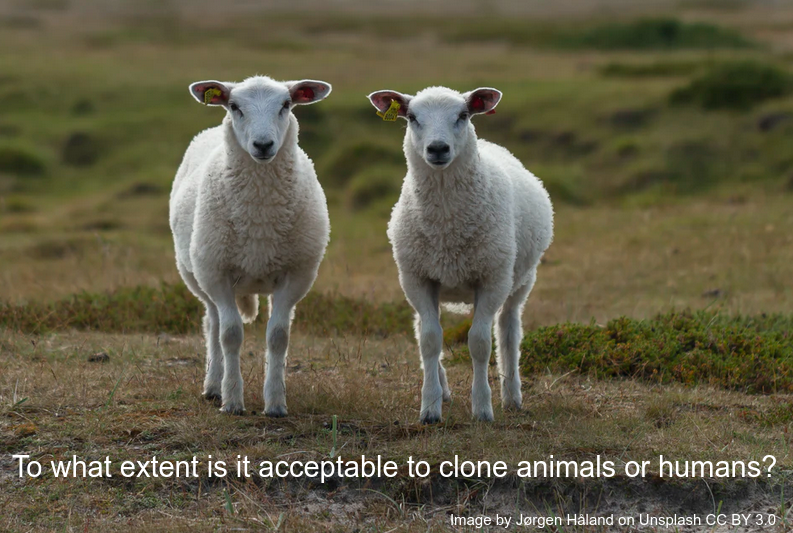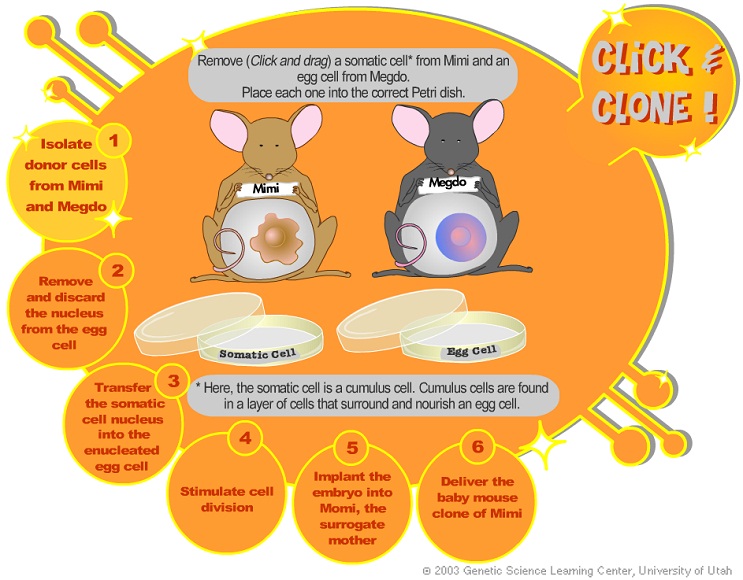Introduction to Cloning.
 This activity introduces reproductive and therapeutic cloning. It begins with examples of reproductive cloning and and a consideration of their implications and some views for and against cloning. Students carry out a short online activity and make notes about the method of somatic-cell nuclear transfer to produce cloned cells. A third longer activity uses another video to guide students through the differences between reproductive cloning and therapeutic cloning. An optional debate activity, using prompt cards to help students understand some of the most relevant issues, completes the set.
This activity introduces reproductive and therapeutic cloning. It begins with examples of reproductive cloning and and a consideration of their implications and some views for and against cloning. Students carry out a short online activity and make notes about the method of somatic-cell nuclear transfer to produce cloned cells. A third longer activity uses another video to guide students through the differences between reproductive cloning and therapeutic cloning. An optional debate activity, using prompt cards to help students understand some of the most relevant issues, completes the set.
Lesson Description
 Guiding Questions
Guiding Questions
To what extent is it acceptable to clone animals or humans?
Identical twins natural clones.
What exactly is different about making a cloned sheep?
Activity 1 Reproductive Cloning is it possible or morally acceptable?
In 2004 Pope John Paul II said, "humanity's speedy progress in science and technology risks overlooking moral values".
Watch the videos below and ask yourself the question, "Is it morally acceptable to do these examples of cloning?"
Complete the ![]() Cloning structured notes worksheet to record your responses.
Cloning structured notes worksheet to record your responses.
Activity 2: Reproductive Cloning by somatic-cell nuclear transfer
Carry out the simulation on the website below. Can you clone a mouse? What are the steps?
Complete the worksheet to summarise the stems taken to clone a mouse using an egg cell and a somatic cell.
Use the ![]() Reproductive Cloning structured notes worksheet below to help record clear notes about somatic cell nuclear transfer.
Reproductive Cloning structured notes worksheet below to help record clear notes about somatic cell nuclear transfer.
Look at this short review of somatic cell nuclear transfer. Add details to the steps written in the first activity.
Activity 3: A video tour of Reproductive cloning and Therapeutic cloning
Watch this video "The Eyes of Nye" (25 mins) which covers the main ideas about somatic cell nuclear transfer for reproductive cloning and then explains how this is different from therapeutic cloning.
Keep notes about the details of therapeutic cloning while watching the video below by answering the questions on the ![]() Cloning - a video tour worksheet
Cloning - a video tour worksheet
Extra Activity 4 - Debate the issues - an ethical thinking activity
How do you work out your personal views about cloning? What type of ethical decision making do you use?
Answer the 'personality quiz' questions Cloning ethics - quiz to find out.
Choose one of the roles from the list below.
Prepare your role for the Hot seat challenge..... what answers will you give to the questions?
Roles of people in the class: (allocated secretly)
- Character 1: Has a medical condition that therapeutic cloning might someday benefit. Is stongly in favour the potential benefits of research over the risks of such research. Does not agree with arguments that cloning human cells is unnatural.
- Character 2: is a close friend or family member of character 1. This character sees the importance of research benefits but also cares strongly for animals and doesn't like seeing animals used in experiments.
- Character 3: Is a business leader. This person has also worked as a research scientist in a lab experimenting with therapeutic cloning. They currently run a company selling medical materials to hospitals.
- Character 4: Is a leader in a local religious group. They are guided by teachings in the scripture, and dislikes procedures which are unnatural.
- Character 5: Is the minister of health. This person is in charge of hospital budgets and needs to be re-elected every five years. There are many pressures on the public purse and this person needs persuading of the value of any new treatment.
- Character 6: Is a charity worker. A strong believer in the the goodness in all people. Everything this person supports is
Question for the Hot seat:
(students take turns to answer the questions in role – then the class guess which role they have been playing)
Dog owners are to be given the chance to clone their pet. Should this be allowed?
- Scientists have grown stem cells from adult bodies using cloning techniques. Is this a good idea? Why?
Does cloning to create stem cells, therapeutic cloning, justify destroying a human embryo? Why, or why not?
Should cloning research be regulated? How, and by whom?
Who has the right to have children, however they are created? Who doesn't?
Is human cloning "playing with nature?" more or less than other reproductive technologies like in-vitro fertilization?
If a clone originates from a single existing person, and an enucleated egg who are the parents?
What are some of the social challenges a cloned child might face?
Brief review of arguments for and against cloning
It might be useful to make a clear separation between questions about reproductive cloning and therapeutic cloning.
Therapeutic cloning is the creation of an embryo to supply embryonic stem cells for medical use.
These are simple notes have been made into cards ![]() Role cards for the hot seat questions to help organisation of the Hot seat challenge or a debate format.
Role cards for the hot seat questions to help organisation of the Hot seat challenge or a debate format.
Teachers' notes
Activity 1 is an introduction to some of the amazing possibilities which reproductive cloning brings and also to ethical questions about reproductive cloning. It's a short activity, aiming to provoke reactions from students and get them wanting more information.
Define Clone:
"a group of genetically identical organisms or a group of cells derived from single parent cell."
Activity 2 looks in detail at somatic cell nuclear transfer as a way to produce cloned cells. This continues with the reproductive cloning of animals, like Dolly the sheep, without going into detail about genetic modification.
This teacher only box contains a suggestion of model answers for the notes from the video. Students cannot see this section.
Outline a technique for cloning using differentiated animal cells.
- 1.Differentiated cell from donor sheep udder was collected and cultured; nucleus removed
- 2.Unfertilized egg collected from another sheep; nucleus removed
- 3.Using a zap of electrical current, the egg cell and the nucleus from the cultured somatic cell were fused together
- 4.New cell developed in vitro and started to form an embryo
- 5.Embryo placed in the womb of a surrogate mother sheep (Actually over 200 surrogate mothers )
- 6.Embryo developed normally
- 7.Dolly was born and presented as a clone of the original donor sheep
- 8. This is known as reproductive cloning
Activity 4: There is an optional fourth activity which is partly developed and provides some ideas for a class debate. It includes a little ethics quiz which is a nice link to TOK and quite possible to do with students even if the debate doesn't follow.
Viewpoint cards and Role cards are also given which can be used in a variety of ways.

 IB Docs (2) Team
IB Docs (2) Team

